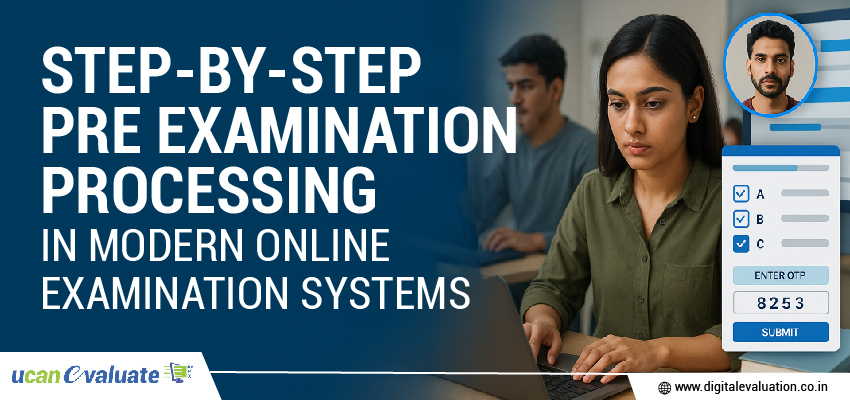A modern Online Examination System succeeds or fails on the strength of its Pre Examination Processing. From application intake to admit card generation, each step must be structured, auditable, and time-bound. Below is a practical, sequential blueprint universities and examination authorities can use to streamline operations at scale.
1) Online Applications: Intake, Validation, and De-duplication
Begin with a unified, standards-based application form mapped to program rules and eligibility criteria.
-
Data validation: Mandatory fields, format checks, real-time de-duplication against prior records.
-
Document capture: Secure uploads (ID, eligibility proofs) with automatic file-type and size checks.
-
Accessibility: Multilingual forms, mobile-first UI, and assisted mode for candidates with accommodations.
Outcome: Clean, structured candidate data ready for downstream processing in the University Examination System.
2) Online Payments: Reconciliation and Audit Trails
Integrate multiple payment gateways (cards, UPI, net banking) with immediate status callbacks.
-
Reconciliation: Auto-match transactions by order ID and candidate reference; flag exceptions.
-
Refund logic: Configurable rules for duplicate or failed payments.
-
Compliance: Full audit trails for finance teams and external audits.
Outcome: Accurate fee status, reduced manual follow-ups, and transparent finance reporting.
3) Application Verification: Manual + Automated Checks
Blend automated checks (age/eligibility calculations, category rules) with configurable maker-checker review.
-
Work queues: Route flagged cases to designated verifiers; enforce SLAs.
-
Bulk actions: Approve/hold/reject with reason codes and automated candidate notifications.
-
Quality gates: Random sampling and inter-rater agreement to control bias and error.
Outcome: Verified candidate pool with traceable decisions and fewer last-minute disputes.
4) Test Venue Audits & Selection: Capacity, Connectivity, Compliance
Whether physical test centers or institutional halls, confirm readiness before allocation.
-
Capacity & layout: Seat maps, aisles, invigilator ratios; disability access checks.
-
Connectivity & power: Bandwidth tests, backup links, UPS/genset logs for online delivery.
-
Security: CCTV coverage, frisking zones, safe material storage, and invigilator briefing plans.
Outcome: A vetted venue roster that supports secure, fair, and scalable delivery.
5) Roll Numbering & Venue/Slot Allocation
Use allocation algorithms that respect capacity, proximity, and special accommodations.
-
Business rules: Reserve buffers for late approvals; handle walk-ins only via designated queues.
-
Conflict checks: Prevent overlapping slots across papers; avoid duplicate seat assignments.
-
Change management: Controlled re-allocation window with candidate notifications.
Outcome: Equitable seat plans and stable timetables that minimize rework.
6) Admit Cards / Hall Tickets & Attendance Framework
Generate QR-coded hall tickets with candidate photo, exam schedule, venue details, and instructions.
-
Security features: Watermarks, unique IDs, and tamper-evident design.
-
Distribution: Candidate portal + email/SMS links; downloadable PDFs for offline access.
-
Attendance setup: Pre-generate attendance sheets or digital attendance via QR/barcode scanning.
Outcome: Clear candidate communication and faster, error-free attendance on exam day.
7) Online Mock Exams: Readiness, Familiarization, and Load Testing
Mock exams reduce anxiety and expose operational gaps early.
-
Candidate practice: Interface walkthroughs, navigation rules, calculator policy, and item types.
-
Tech rehearsal: Peak-load tests on the Online Exam Solution; proctoring and evidence-log checks.
-
Issue resolution: Helpdesk scripts, FAQs, and retry windows before the actual exam.
Outcome: Fewer support calls, smoother delivery, and higher first-time-right rates.
Governance, Reporting, and Risk Controls
-
Dashboards: Live counts for applications, verifications, payments, allocations, and hall ticket downloads.
-
Compliance: Role-based access, encryption at rest/in transit, and event logs.
-
Contingencies: Playbooks for power/network failure, center blacklisting, and emergency re-scheduling.
Outcome: Predictable operations and defensible records that support On-Screen Evaluation and audit needs later.
Real-world note: Institutions that codify these steps into SOPs typically shorten turnaround by 20–30% while reducing candidate queries and center-day incidents.
Learning Spiral supports end-to-end Pre Examination Processing with configurable workflows, robust security, and integrations that hand off clean data to downstream Digital Evaluation and On-Screen Marking.



